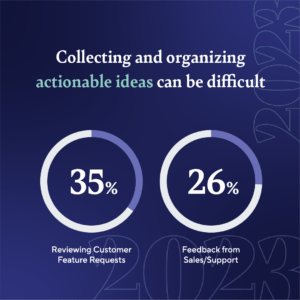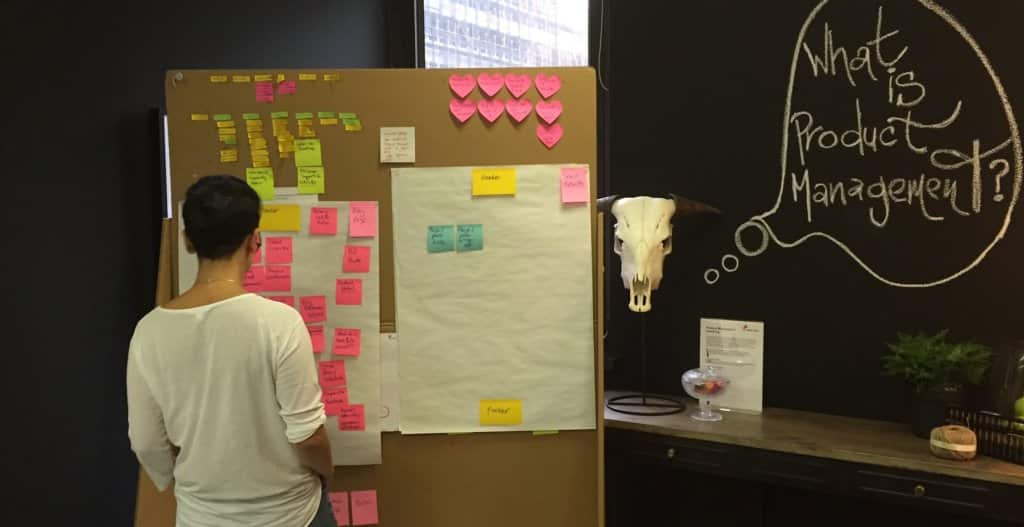Does your product team celebrate launching that feature they’ve spent the last three months working on and then never give it another thought until it breaks? Is the senior leadership at your organization constantly ordering you to work on the top 10 priorities that change every other day? Are you too busy to reflect on how your product team can work better together? Then you probably have to begin to face the challenges of being in a feature factory.
What is a feature factory?
John Cutler coined the term feature factory upon hearing a software development friend complain that he was “just sitting in the factory, cranking out features, and sending them down the line.”
The term has gained traction ever since. And even with all the bad-mouthing that feature factories have received since John originally coined the term, they still exist.
ProductPlan’s 2023 State of Product Management Report found that 54% of roadmaps are designed around outputs. Only 43% communicate outcomes.
Who knows what the other 3% focus on…
What happens when a product team is a feature factory
So are feature factories all that bad? After all, you’re producing a lot of features. Isn’t that a good thing? Not always, no. Your unrelenting focus on pushing features out to market results in multitasking, over-utilization, and the hard-core environment that only Elon Musk would love.
Ways to know your team is a feature factory:
- You produce a lot of features, but you don’t always know how they relate to each other and if they produce a viable solution.
- Your product becomes too complicated to use. You constantly add features and never remove any.
- Your product becomes too difficult to maintain. When you furiously add features without considering how they work with existing features, you end up with a maintenance nightmare.
- You introduce many features, but you never take the time to reflect on how to improve them. Instead of iterating, you move on to the next big thing.
- You’re more likely to introduce features solely for the sake of closing a big deal, which leads to several of the issues described above.
How does a product team become a feature factory?
Ok, so if feature factories are so bad, why do so many product teams go down that path? Our 2023 State of Product Management Report gave some clear indicators. Per the report: “Reviewing customer feature requests” is the number one source of actionable product ideas (35%).

That’s not too surprising because feature requests (usually expressed as a solution) can seem like an easy way to decide what to work on.
But when you don’t dig deeper into those requests and identify the underlying problem, you risk hoping on the feature conveyor belt – introducing features with no overarching understanding of why except for “our customers asked for it.”
Role of senior leadership
Senior leadership is also a common source of product ideas, according to the report. That source of ideas comes with a big downside – a lack of product manager confidence.
The report explained product managers are “five times more likely to rate their confidence [in their ability to identify problems worth solving] at one out of six when ideas come from senior leadership compared to respondents getting their ideas from other sources”
Suppose senior leadership tells you what to build. In that case, you’re probably not going to be very confident in your ability to identify problems to solve, and you’re more likely to focus on outputs.
Another reason teams focus on outputs and risk becoming feature factories because it’s hard to measure outcomes.
When asked if the return on product development investments meets their senior leadership’s expectations, nearly a third of PM’s responding to the survey said, “I don’t know.” Based on the low adoption of tools for post-release evaluation and reporting, you could interpret that as a sign that they aren’t measuring return on investment.
So if you don’t have a good way to measure return on investment, the path of least resistance is to measure progress by how much stuff you’ve delivered. As proof of that, 70% of roadmaps most influenced by senior executives focus on communicating outputs over outcomes.
A final cause of feature factories is a poor execution of your product strategy or lack of a clear product strategy.
Ideally, your product strategy provides the tie between your business’ goal and objectives and your plans for your product. Suppose you don’t have that guiding north star. In that case, you’re more likely to find yourself whipsawed from one emergency feature release to the next to satisfy the loudest customer or the latest HiPPO (Highest Paid Person’s Opinion).
Feature factory, here we come.
How to avoid the trap
It doesn’t have to be that way. There are some simple ways that your product team can avoid the soulless monotony of cranking out features.
To start, change how you communicate what you’re building and why. Talk more about the value you’re delivering and less about the specifics of the features you’re working on.
Next, treat customer requests as feedback – Talk directly to your customers, and learn how to read into their requests to find the underlying problem. After all, customer requests are feedback, not requirements.
Finally, give product teams a mission – a problem to solve – and let them figure out how to solve it. When the outcome comes from leadership, it should be clear they care about it, so your team will look to how well they’re solving the identified problem as your gauge of success.
Want more insights like this?
Check out our 2023 State of Product Management Report to get in-depth information about where product teams are now and where they’re headed.





